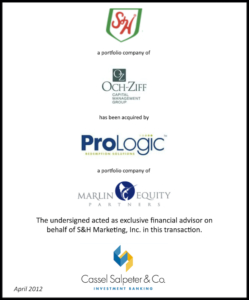Tips for Picking the Right Business Loan
To view original article click here.
The size of your business, the purpose of the loan and how you operate your firm play a big part in the type of loan that’s available and right for you.
By: James Cassel
MIAMI, Florida, May 21, 2012 – Thinking about taking your business to the next level, or simply sustaining it through challenging times? You’ll need effective management, stamina and, most importantly, money. However, accessing funds for growth capital, cash-flow shortages, an acquisition, or because your lender cut you off can be a complex and daunting challenge. Let’s ignore equity for now. Loans have different risks and costs, and the size of your business, the purpose of the loan and how you operate your company play a big part in the type of loan that’s available and right for you.
Many owners “bootstrap” their businesses — looking to personal savings, credit cards and their regular income as a source of capital. But, when those options are exhausted, where can an entrepreneur turn for cash? Getting to know your options is a good first step. If you’re seeking to borrow in excess of $5 million, you can turn to an investment banker who can identify sources of capital and evaluate terms of a deal. Regardless, every business is different, and all business loans are not created equal. Remember, with money comes strings.
Friends and family: If you’ve thought about friends and family as a source of financing, you’re not alone. However, don’t assume these loans are “free.” Even when working with friends and family, the deal should be an arm’s-length transaction (although this is not always the case). Therefore, the interest rate, loan-to-value, and terms must reflect — or nearly reflect — market rates, no matter what the relationship between lender and borrower.
Pros: Since these loans are based on relationships, not necessarily credit worthiness, they can be good for business owners with less-than-perfect credit or collateral. In addition, if you are running short on time, you can often get a loan more quickly than from banks or other financial institutions. You might also be able to get lower interest rates and less-restrictive terms, even in the context of an arm’s-length transaction.
Cons: Every loan carries risk, and if your ability to pay back the loan changes, then your relationship with the friend or family member could be jeopardized. Plus, when you borrow from friends and family, there are often strings attached, including unsolicited business advice, feelings of entitlement and expectations of continued involvement after the loan is paid off.
Cash-flow loans: As the name implies, cash-flow loans are generally unsecured loans, whereby the lender looks to anticipated cash flow to repay the loan and requires certain financial and nonfinancial covenants be met. With this type of loan, you take advantage of the reliability and regularity of your company’s revenue stream. Traditional commercial banks and certain finance companies frequently make these loans. For smaller businesses, the lenders will generally require personal guarantees.
Pros: Cash-flow loans can be useful to fund an acquisition because you can use the cash flow of the company you are acquiring (in addition to your own) to repay the loan. If you have a stable credit history, as well as predictable and growing cash flow, cash-flow loans provide a fairly flexible source of funding.
Cons: Small and mid-sized companies with fewer customers, smaller contracts and less-reliable income may have more difficulty obtaining these types of loans. Similarly, companies with shorter operating histories may not be able to demonstrate the necessary consistency of cash flow to secure a loan.
Asset-based loans: Both small and large businesses can consider asset-based loans, which are based on the value of hard assets, receivables and inventory for determining borrowing limits. The amount of money available to borrow is generally based on a formula.
Pros: Asset-based lending is flexible, since you can use accounts receivable and inventory as collateral. If your company has less-than-perfect credit, asset-based lending could be for you — especially if you find a lender who specializes in your industry. You may also be able to access capital more rapidly than through a loan based on operating income and other financial measures.
Cons: One of the drawbacks to an asset-based loan is the formula. One example: If you are only allowed to borrow on accounts receivable less than 90 days old. If you are not paid by then, you will need to pay back that portion of the loan anyway. In addition, if the assets reduce in value, you may owe more than those assets are worth. Plus, lenders discount assets when determining how much they will loan your business. For example, a lender may not loan anything against foreign receivables, 50 percent of the value for work in progress and perhaps 80 percent of the value of U.S. receivables.
Factoring: Factoring, or selling your accounts receivable for cash, provides your business with working capital. However, the value of your receivables will be greatly affected by your customers’ payment history. If you have had a hard time collecting from customers, the factoring company will likely have a difficult time as well. Accordingly, the amount of money you can expect — and the cost of that money — will be reflected by this. Factoring can be with or without recourse. There may also be certain holdbacks on the purchase price.
Pros: Instead of waiting for clients to remit payment, you’ll have faster access to money owed to your business. Also, since factoring focuses on your customers’ credit worthiness and not yours, you can access capital without the lender scrutinizing your business’ credit worthiness.
Cons: Factoring can be expensive. Factoring companies charge fees and buy the receivables at a discount (the equivalent of interest). They charge a premium for the risk of nonpayment by your customers.
Other Options for Small Businesses: Even in today’s post-credit-crunch environment, business owners might perceive that lending options are scarce. In addition to what I have mentioned, other available types of loans include purchase-order financing, international accounts receivable financing, and mezzanine financing, as well as hard-money lenders.
The fact is, commercial lending is more plentiful than it has been in several years. Banks and other financiers have lots of cash to lend. So, always consider your primary banking relationship as a viable source of capital.
In addition, companies have access to resources, including the U.S. Small Business Administration (SBA). The SBA guarantees loans issued by commercial banks and has a variety of programs based on your company’s size, industry and stage of development. This can enhance your credit worthiness. And, don’t let the word “small” fool you. The SBA defines small businesses differently from what you may think.
Today’s entrepreneurs can also use the Internet to find loans. There are a growing number of sites trying to assist with both debt and equity. Try Boefly.com for loans or examine “crowd-funding” sources. Microloan financing destinations like Kiva.org may be able to provide businesses with the financial boost they need.
Aside from evaluating loans, you should also compare lenders. Look beyond interest rates at terms, fees and costs. Also, consider how much experience your lender has in your industry and its willingness to stick with you over time. When you think you have found the right lender, examine how it addressed past crises and current media attention. And, no matter what you decide, never finance a long-term asset with a short-term loan.
With an honest evaluation of your borrowing potential, you will be set for the next stage in your business, whatever that may be.






